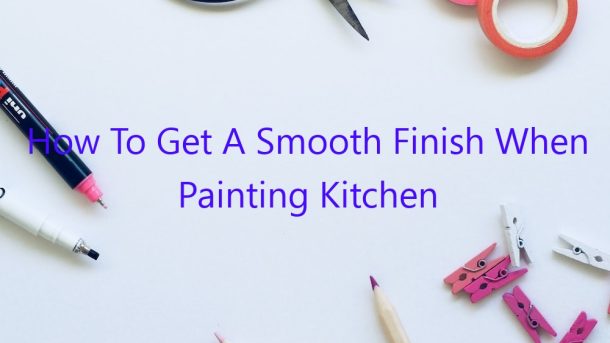Are you about to paint your kitchen cabinets? If so, you’re likely looking for ways to get a smooth finish. Here are a few tips to help you achieve the look you want.
1. Start by sanding your cabinets thoroughly. This will remove any debris or rough patches that might otherwise compromise the finish.
2. Next, apply a coat of primer. This will help the paint adhere better and will also help to ensure a smooth finish.
3. Finally, apply the paint. Use a brush or roller to apply it in smooth, even strokes. Be sure to let the paint dry completely before applying a second coat.
If you follow these steps, you should be able to achieve a smooth finish on your kitchen cabinets.
Contents [hide]
How do you get the smoothest finish when painting cabinets?
In order to get the smoothest finish possible when painting cabinets, you need to take a few steps. First, make sure the surface of the cabinets is clean and free of dust and dirt. You can do this by using a damp cloth to wipe them down. Then, use a primer to cover the surface of the cabinets. This will help to ensure a smooth finish when you apply the paint. Finally, use a good quality paint and a brush that is in good condition. Be sure to brush in the direction of the wood grain, and to avoid painting over the same area more than once. If you follow these steps, you should be able to achieve a smooth finish when painting your cabinets.
What paint roller gives the smoothest finish on cabinets?
When painting cabinets, it is important to use a roller that will give a smooth finish. A regular paint roller can leave behind streaks and bumps, which can be visible once the paint is dry.
A good option for obtaining a smooth finish is a foam roller. This type of roller is made from foam rubber, which helps to produce a smooth surface. Additionally, foam rollers are less likely to leave paint streaks or bumps.
Another option for obtaining a smooth finish is a microfiber roller. This type of roller is covered in tiny fibers, which help to produce a smooth surface. Additionally, microfiber rollers are less likely to leave paint streaks or bumps.
When choosing a roller for painting cabinets, it is important to consider the type of finish that is desired. If a smooth finish is desired, then a foam or microfiber roller should be used.
How do you paint cabinet doors without brush marks?
There are a few different ways to avoid brush marks when painting cabinet doors. One way is to use a foam roller. Roll the paint on in a thin layer, and then use a brush to smooth it out. Another way is to use a paint sprayer. Spray the paint on in a thin layer, and then use a brush to smooth it out.
Is it better to roll or brush paint cabinets?
When painting cabinets, there are two main ways to apply the paint: rolling or brushing. Both have their pros and cons, so it can be tough to decide which method is better. Here’s a look at the pros and cons of each method:
Rolling:
-Pros: Rolling paint is quick and easy. It also results in a very smooth finish.
-Cons: It can be difficult to get paint into all the nooks and crannies with a roller, so there is a greater chance of leaving streaks or missed spots.
Brushing:
-Pros: Brushing allows for more control over the paint application, so it’s easier to avoid streaks and missed spots.
-Cons: It’s a more time-consuming process, and can be a bit more difficult to get a smooth finish.
Why do my cabinets feel rough after painting?
After painting your cabinets, you may notice that they feel rough to the touch. This is a common issue, and there are several possible causes. In this article, we’ll explore some of the reasons why your cabinets may feel rough after painting, and we’ll also suggest some solutions.
Possible Causes
One of the most common reasons why cabinets feel rough after painting is because of the paint itself. Many paints contain a high level of solids, which can cause a rough texture. In addition, some paint formulations can contain grit or sand, which can also cause a rough finish.
If your cabinets feel rough after painting, it’s important to determine whether the problem is caused by the paint or by the surface of the cabinets. To do this, rub your hand over the surface of the cabinets. If the cabinets feel rough to the touch, the problem is likely caused by the paint. If the cabinets feel smooth, the problem is likely caused by the surface of the cabinets.
Solution
If the problem is caused by the paint, the best solution is to lightly sand the surface of the cabinets. This will remove the rough texture caused by the paint. Be sure to use a fine-grit sandpaper, and be careful not to sand too heavily, or you may damage the surface of the cabinets.
If the problem is caused by the surface of the cabinets, a light sanding may also be helpful. However, in some cases, the only solution is to repaint the cabinets.
What do professionals use to paint cabinets?
There are many different products that professionals use to paint cabinets. Some of the most popular products are cabinet paints, primers, and sealers.
Cabinet paints are specially formulated to adhere to cabinets and provide a durable finish. They come in a wide range of colors, and many brands offer both matte and glossy finishes.
Primers are essential for ensuring a good finish on cabinets. They create a smooth surface for the paint to adhere to, and they help to hide any imperfections in the cabinet surface.
Sealers are also important for cabinets. They protect the paint from moisture and humidity, and they help to prevent the formation of mold and mildew.
How do you prevent roller marks when painting cabinets?
Roller marks can be a common issue when painting cabinets, and can be frustrating to try to fix. In order to prevent them, it is important to use the right techniques and materials. Here are a few tips on how to prevent roller marks when painting cabinets:
1. Make sure to use a good quality roller and roller cover. A good roller will help to avoid any marks or streaks.
2. Always use a primer before painting. This will help to create a smooth surface and will prevent the paint from seeping through the cracks and marks.
3. Paint in thin layers. Trying to paint too much at once can lead to roller marks. By painting in thin layers, you will avoid this issue.
4. Use a light touch when rolling. Avoid applying pressure to the roller, as this can also cause marks and streaks.
5. Finish up by rolling in the opposite direction. This will help to smooth out any marks that may have been caused by the roller.




